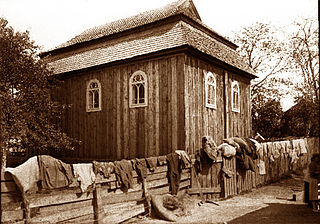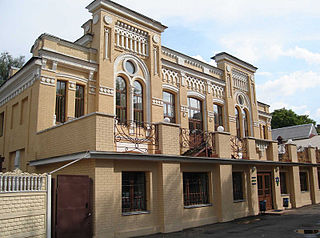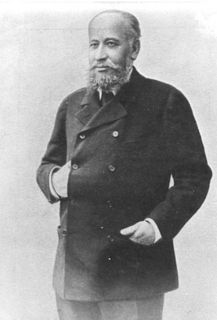
A synagogue, also called a shul or temple, is a Jewish house of worship. The term "synagogue" is also occasionally used to describe a Samaritan house of worship. Synagogues have a place for prayer and may also have rooms for study, a social hall, offices, and classrooms.

A Torah ark refers to an ornamental chamber in the synagogue that houses the Torah scrolls.

Bila Tserkva is a city in the center of Ukraine, the largest city in Kyiv Oblast, and part of the Right Bank. It serves as the administrative center of Bila Tserkva Raion and hosts the administration of Bila Tserkva urban hromada, one of the hromadas of Ukraine. Bila Tserkva is located on the Ros River approximately 80 km (50 mi) south of Kyiv. The city has an area of 67.8 square kilometres (26.2 sq mi). Its population is approximately 208,737

Mykola Dmytrovych Leontovych was a Ukrainian composer, conductor, ethnomusicologist and teacher. His music was inspired by Mykola Lysenko and the Ukrainian National Music School. Leontovych specialised in a cappella choral music, ranging from original compositions, to church music, to elaborate arrangements of folk music.

A kenesa is an Eastern European or Persian Karaite synagogue.

The Leopoldstädter Tempel was the largest synagogue of Vienna, in the district (Bezirk) of Leopoldstadt. It was also known as the Israelitische Bethaus in der Wiener Vorstadt Leopoldstadt. It was built in 1858 in a Moorish Revival style by the architect Ludwig Förster. The tripartite facade of the Leopoldstädter, with its tall central section flanked by lower wings on each side, became the model for numerous Moorish Revival synagogues, including the Choral Temple in Bucharest, which has an almost identical main facade, the Zagreb Synagogue, the Spanish Synagogue in Prague, the Tempel Synagogue in Kraków and the Grand Synagogue of Edirne.

Moorish Revival or Neo-Moorish is one of the exotic revival architectural styles that were adopted by architects of Europe and the Americas in the wake of Romanticist Orientalism. It reached the height of its popularity after the mid-19th century, part of a widening vocabulary of articulated decorative ornament drawn from historical sources beyond familiar classical and Gothic modes. Neo-Moorish architecture drew on elements from classic Moorish architecture and, as a result, from the wider Islamic architecture.

The Great Choral Synagogue of Kyiv, also known as the Podil Synagogue or the Rozenberg Synagogue, is the oldest synagogue in Kyiv, Ukraine. It is situated in Podil, a historic neighborhood of Kyiv, and is under the leadership of Rabbi Bleich, Chief Rabbi of Ukraine.

Moshe Reuven Asman is one of the Chief Rabbis of Ukraine after former president Viktor Yushchenko named him as a contact person for Jewish matters.

The Grand Choral Synagogue of Saint Petersburg is the third-largest synagogue in Europe. Other names include The Great Choral Synagogue of Saint Petersburg and The Edmond J Safra Grand Choral Synagogue. Sometimes it is simply referred to as the Saint Petersburg Synagogue or Bolshaya Sinagoga. It was built between 1880 and 1888, and consecrated in December 1893. The synagogue is located at 2 Lermontovskii Prospekt, Saint Petersburg, Russia. The Chief Rabbi of Saint Petersburg is Menachem Mendel Pewzner. Today the synagogue is a registered landmark and an architectural monument of federal importance.

The Galitska Synagogue is a synagogue in Kyiv, Ukraine. It is under the Leadership of the Chief Rabbi of Ukraine, Rabbi Yakkov Bleich.

The Brodsky Choral Synagogue is the second largest synagogue in Kyiv, Ukraine. It was built in the Romanesque Revival style resembling a classical basilica. The original tripartite facade with a large central avant-corps flanked by lower wings also echoed the characteristic design of some Moorish Revival synagogues, such as the Leopoldstädter Tempel in Vienna.

The burning of the Riga synagogues occurred in 1941, during the first days of the World War II Nazi German occupation of the city of Riga, the capital and largest city in the country of Latvia. Many Jews confined in the synagogues died in the fires. Many other anti-Semitic measures were launched at the same time, ultimately followed by the murder of the vast majority of the Jews of Latvia.

Lazar Izrayilevich Brodsky was a Russian Imperial businessman of Jewish origin, sugar magnate, philanthropist and patron.

The Choral Synagogue of Vilnius is the only synagogue in Vilnius that is still in use. The other synagogues were destroyed partly during World War II, when Lithuania was occupied by Nazi Germany, and partly by the Soviet authorities after the war.

The Kharkiv Choral Synagogue is a synagogue located in Kharkiv, Ukraine, the largest in the country, and a building of architectural significance.
The history of the Jews in Kyiv stretches from the 10th century CE to the 21st century, and forms part of the history of the Jews in Ukraine.

The Great Synagogue or Choral Synagogue in Bila Tserkva, Kyiv Oblast, in Ukraine, was built in the middle of the 19th century. Today the building, which is in good condition, is used as a college.
Choral Synagogue may refer to:
















